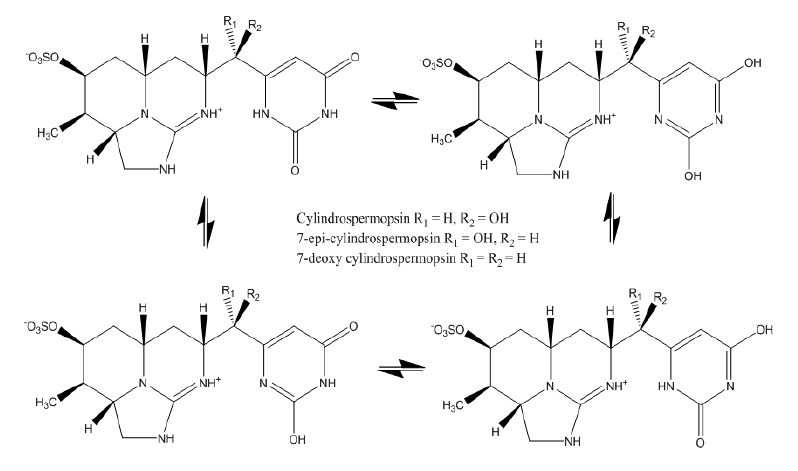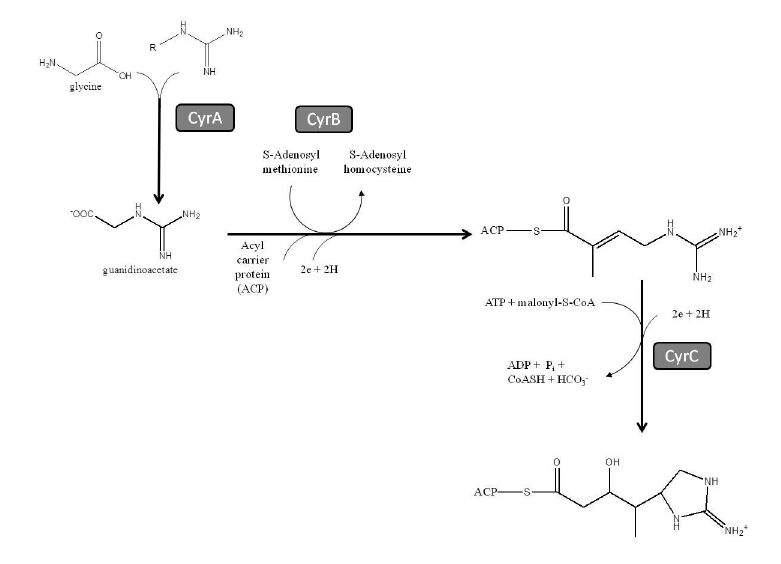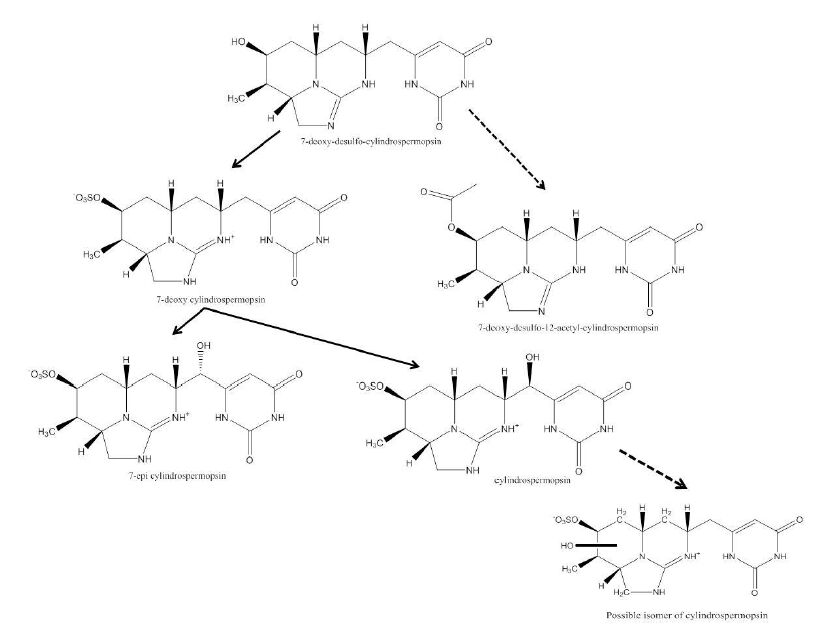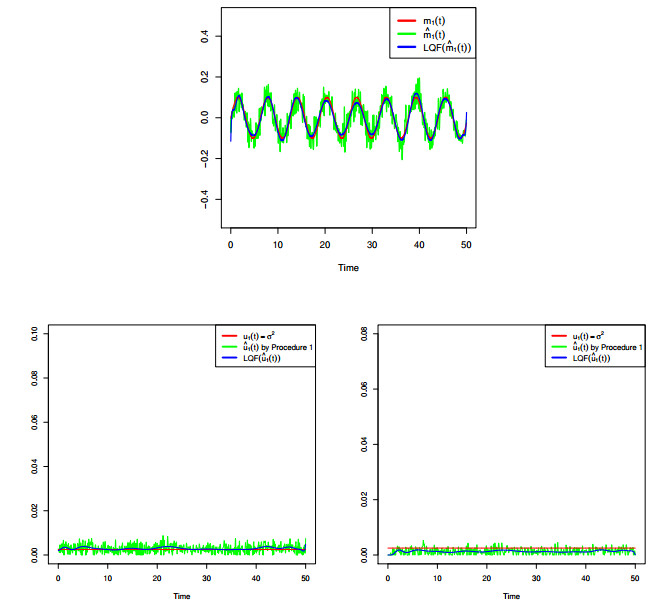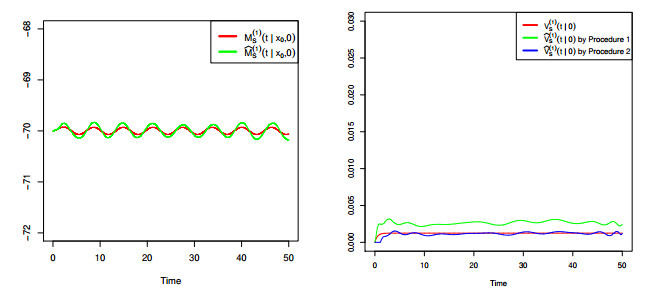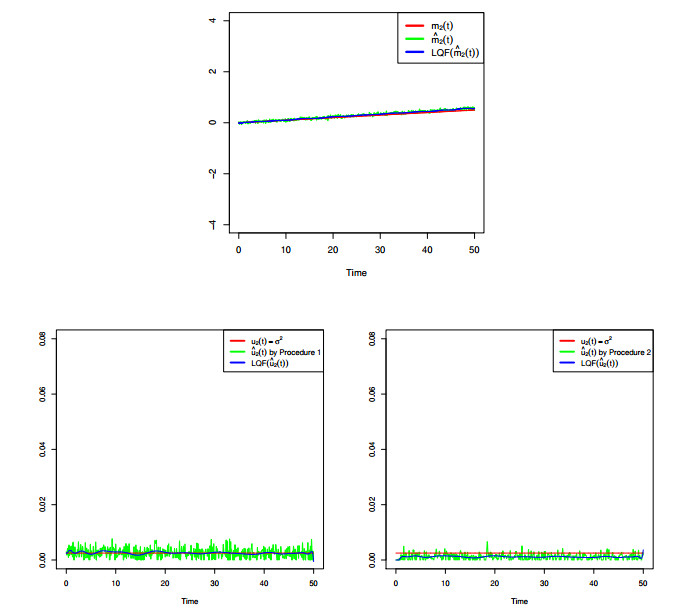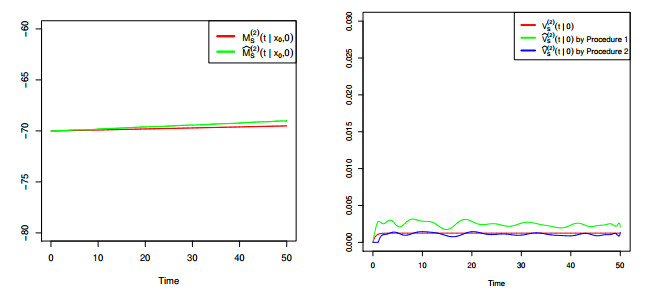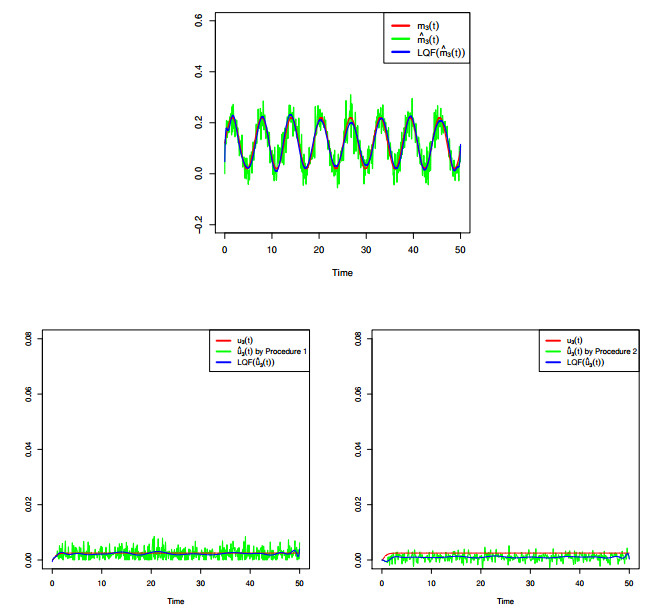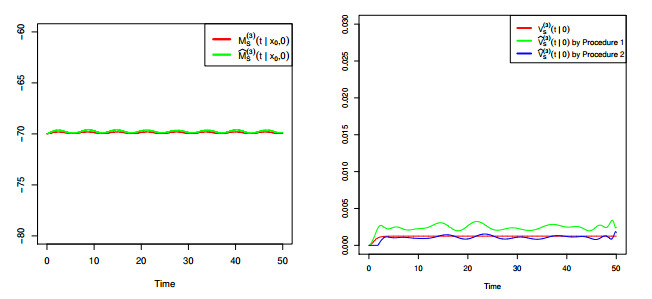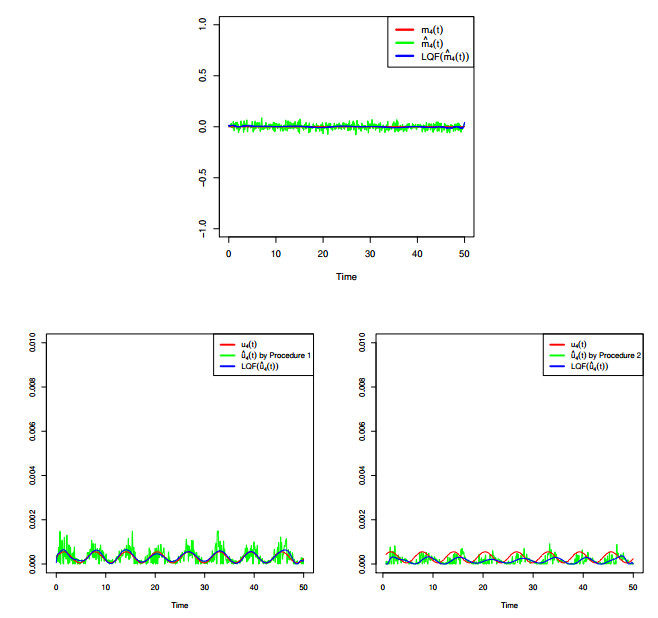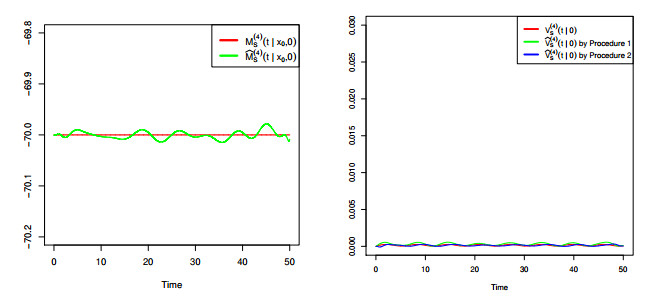1. Introduction
The occurrence of the alkaloid cytotoxin cylindrospermopsin (CYN) in cyanobacterial blooms has been well documented over the past 30 years [1,2,3,4,5,6,7,8]. In actual fact, there are now known to be a whole family of toxins, with structural similarities to cylindrospermopsin that are produced by various cyanobacteria.Cylindrospermopsin is the most thoroughly-researched member of thisfamily [9]. A number of recent reviews have dealt with various aspects of cylindrospermopsin, including the range of cylindrospermopsin producers, physiology of toxin production, and toxic endpoints [5,6,7].
Cylindrospermopsin is one of five known compounds, distinguished by variations in substitution patterns on a core chemical backbone. As of August 2014, the molecules classified as cylindrospermopsins can be listed as: cylindrospermopsin; 7-deoxy-cylindrospermopsin (DCYN); 7-epi-cylindrospermopsin, 7-deoxy-desulfo-cylindrospermopsin and 7-deoxy-desulfo-12-acetylcylindrospermopsin. The occurrence of at least some of these forms has been known for a considerable period of time [10] (Orr et al., 2011), whilst others have been only recently discovered [9]. Although the other forms of cylindrospermopsin are known to be co-produced with cylindrospermopsin, corresponding studies on their occurrence, production and toxicity are generally lacking [11,12,13,14].
For at least some time, the lack of attention given to the other members of the cylindrospermopsin family could be partly justified as they were believed to be only very minor constituents of the total cylindrospermopsin pool and were believed to exhibit no toxic activity. More recently, a number of reports have demonstrated that at least 7-deoxy-cylindrospermopsin can occur in quantities comparable to, or even greater than cylindrospermopsin and that ratios may change under differing physiological conditions.Moreover, at least in cell cultures, 7-deoxy-cylindrospermopsin has been shown to be of approximately similar toxic potency to cylindrospermopsin [12]. These observations, along with the demonstration of potential effects of cylindrospermopsin on interspecific competition in cyanobacteria [15], point to a need to re-examine the roles of all other forms of cylindrospermopsin.
This paper reviews the state of knowledge of the cylindrospermopsin family, placing particular emphasis on those forms in which the native molecule is modified. Data are presented on the occurrence, production and in vitro toxicity of the other cylindrospermopsin forms. Finally, an attempt is made to rationalize the information to hand and define possible roles for the modified cylindrospermopsins as well as to appreciate their potential significance in relation to variations in environmental conditions, including those expected to accompany climate change.
2. The cylindrospermopsins
2.1. Structures, chemical properties and synthesis
To date, five members of the cylindrospermopsin family have been identified and their structures confirmed. Their structures are shown in Figure 1.
Cylindrospermopsin was the first member of the family to be structurally characterized and was described by Ohtani et al. (1992) [2]. The correct structure was assigned to this compound by Heintzelman et al. (2002) [16]. The basic molecule consists of a tricyclic guanidine group attached to a hydroxymethyl uracil and is the most frequently encountered form of cylindrospermopsin. Because the purpose of this review is not to cover the material pertaining to cylindrospermopsin, a detailed description of the occurrence of this molecule will not be presented. It will simply be stated that the molecule is known to be produced by Cylindrospermopsis raciborskii, Aphanizomenon ovalisporum, Aphanizomenon flos-aquae, Aphanizomenon gracile, Raphidiopsis curvata, Raphidiopsismediterranea (now believed to represent the non-heterocytous life-cycle stages of Cylindrospermopsis raciborskii, [17]), Anabaena bergii, Anabaena lapponica, Anabaena planctonica, Umezakia natans and Lyngbyawollei. Further details on the occurrence of cylindrospermopsin in various cyanobacteria (including geographical distribution) are given by Kinnear (2010) [5].
However, in addition to this molecule, five analogues of cylindrospermopsin have been identified and the structures of four have been fully characterized. The occurrence of these various cylindrospermopsin forms is further described in Table 1. The possibility exists that additional cylindrospermopsin forms may be discovered in the future.
Table 1. Occurrence of other cylindrospermopsin forms.
|
Cylindrospermopsinform
|
Organism/Organisms in which occurrence confirmed
|
Reference
|
|
7-epi-cylindrospermopsin
|
Aphanizomenon ovalisporum
Oscillatoria sp. strain PCC 6506
|
[18]
[19]
|
|
|
Oscillatorias trains
|
[20]
|
|
7-deoxy-cylindrospermopsin
|
Cylindrospermopsis raciborskii
|
[21]
|
|
|
Raphidiopsis mediterranea
Raphidiopsis curvata CHAB1150
|
[11]
[22]
|
|
|
Lyngbya wollei
|
[23]
|
|
7-deoxy-desulfo-cylindrospermopsin
|
Thai strain of Cylindrospermopsis raciborskii
|
[9]
|
|
7-deoxy-desulfo-12-acetyl-cylindrospermopsin
|
Thai strain of Cylindrospermopsis raciborskii
|
[9]
|
Cylindrospermopsin analogues could exist in several tautomeric forms, however, NMR data only support the existence of keto form exclusively for the two isomers cylindrospermopsin and 7-deoxy-cylindrospermopsin. Some possible tautomers are shown in Figure 2 [24].
Total syntheses of cylindrospermopsin, 7-epi-cylindrospermopsin and 7-deoxy-cylindrospermopsin have been achieved [25]. Finally, although this is not a review of cylindrospermopsin analytical methodology, it should be noted that instrumental techniques such as LC-MS-MS are the only ones capable of satisfactorily quantitating cylindrospermopsin forms [6].Immunoassay kits currently available do not resolve the various cylindrospermopsin forms [20]. The coupling of conventional pyrolysis techniques, or thermochemolysis in the presence of tetramethylammonium hydroxide salts to GCMS, has been suggested as a rapid means of quantifying cylindrospermopsin within the concentration range encountered in infestations [26]. However the ability of the techniques to differentiate amongst the various cylindrospermopsin forms was not investigated.
2.2. Hyperproducers of 7-deoxy-cylindrospermopsin and other cylindrospermopsin forms
Of the various forms of cylindrospermopsin, 7-deoxy-cylindrospermopsin has received the most attention. The initial discovery of 7-deoxy-cylindrospermopsin indicated that it (along with most other cylindrospermopsin analogs) to be generally present in relatively small amounts, when compared to cylindrospermopsin [21]. More extensive investigation of the occurrence of the cylindrospermopsins in subsequent years has revealed that 7-deoxy-cylindrospermopsin in particular is not always a minor component.
For example, Everson et al. (2009) [13] reported the occurrence of cylindrospermopsin and 7-deoxy-cylindrospermopsin at approximately equal concentrations in a Northern New South Wales lake which was experiencing an infestation of Cylindrospermopsis raciborskii and Aphanizomenon ovalisporum. Similarly, Orr et al., 2010 [27] reported measurements of cylindrospermopsin and 7-deoxy-cylindrospermopsin at a number of sites in a Queensland freshwater storage.Levels of 7-deoxy-cylindrospermoppsin were consistently higher than those of cylindrospermopsin with a maximum ratio of 3.9:1. The hyperproduction of 7-deoxy-cylindrospermopsin is not limited to the Australian situation. Shihana et al. (2012) [28] reported on an infestation (in which Cylindrospermopsis raciborskii was the predominant species) in Padaviya reservoir, Sri Lanka.The ratio of 7-deoxy-cylindrospermopsin to cylindrospermopsin was 42:1.
Li et al. (2001) [11] studied strains of Raphidiopsis curvata isolated from a pond in Wuhan, China. 7-deoxy-cylindrospermopsin and cylindrospermopsin concentrations in the dried cell extracts were 1300 μg/g and 0.56 μg/g respectively, giving a 7-deoxy-cylindrospermopsin:cylindrospermopsin ratio of 2321:1. The relationship between Cylindrospermopsis raciborskii and Raphidiopsis mediterranea has been discussed above (viz. Raphidiopsis mediterranea is now believed to represent the non-heterocytous life-cycle stages of Cylindrospermopsis raciborskii, [17]). McGregor et al. (2011) [14] reported a ratio of 7-deoxy-cylindrospermopsin:cylindrospermopsin of 1:16 in a Raphidopsis mediterranea infestation from Lake Clarendon in South-east Queensland.The
studies were further supported by demonstration of the presence of cylindrospermopsin synthesizing genes.
The mat-forming benthic cyanobacterium Lyngbya wollei, which is commonly found in freshwater environments in South-east Queensland has also been reported to be a hyperproducer of 7-deoxy-cylindrospermopsin [23]. On a dry weight basis, the ratio of 7-deoxy-cylindrospermopsin to cylindrospermopsin was 27.5:1 for field collected samples, with a 7-deoxy-cylindrospermopsin content of 550 μg/g dry weight. When an isolate from the field was maintained in culture over 16 months, the 7-deoxy-cylindrospermopsin to cylindrospermopsin ratio was 9.3:1, compared to 27.5:1 for field collected samples, with a 7-deoxy-cylindrospermopsin content of 308 μg/g dry weight.
Table 2 summarizes the findings of various authors as regards cylindrospermopsinhyperproducers.
Table 2. Reports of significant production of 7-deoxy-cylindrospermopsin and 7-epi-cylindrospermopsin.
|
Organism
|
Type of experiment
|
Source of Organisms
|
Ratio of 7-deoxy- cylindrospermopsin to cylindrospermopsin
|
Author
|
|
Cylindrospermopsis raciborskiiStrain NPD
|
Laboratory culture
|
Lake Samsonvale. South-east Queensland
|
Varied according to strain. Intracellular ratio varied during growth cycle
0.2:1-1.6:1
|
[29]
|
|
Cylindrospermopsis raciborskii and Aphanizomenon ovalisporum
|
Field Collection
|
Cobaki Lake, New South Wales
|
1.1:1 (according to data supplied).
Ratio increased with depth
|
[13]
|
|
Cylindrospermopsis raciborskii (dominant species)
|
Field Collection
|
Padaviya reservoir, North Central Sri Lanka
|
42:1
|
[28]
|
|
Raphidiopsis curvata
|
Laboratory culture
|
Wuhan, China
|
2321:1.
|
[11]
|
|
Raphidiopsis mediterranea
|
Field collection
|
Lake Clarendon, South-east Queensland
|
1.16
|
[14]
|
|
Lyngbya wollei
|
Field Collection
|
South-East Queensland
|
27.5:1
|
[23]
|
|
Lyngbya wollei
|
Laboratory culture
|
South-East Queensland
|
9.3:1
|
[23]
|
|
Oscillatoria sp. strain PCC 6506
|
Lab Culture
|
|
7-epi-cylindrospermopsin major
|
[19]
|
|
Raphidiopsis curvata CHAB1150
|
Lab Culture
|
China
|
7-deoxy-cylindrospermopsin exclusively
|
[22]
|
Mazmouzet al. (2011) [20] examined a number of Oscillatoria strains of diverse origin and habitat, these strains having been maintained in culture for a number of years. The strains were found to produce cylindrospermopsin, 7-epi-cylindrospermopsin and 7-deoxy-cylindrospermopsin in different relative concentrations. Although 7-deoxy-cylindrospermopsin was always a minor metabolite, the relative concentrations of 7-epi-cylindrospermopsin and cylindrospermopsin varied. In particular, three strains (one isolated from California, USA in 1964; one isolated from the Tarn River, Les Vignes, France in 2006 and one of unknown origin) were shown to produce 7-epi-cylindrospermopsin in concentrations 2.3-3.1 times that of cylindrospermopsin.
2.3. Physiology of cylindrospermopsin/7-deoxy-cylindrospermopsin/7-epi-cylindrospermopsin occurrence
All of the above data pertain to collections of the parent organisms/culture media/contaminated water at a fixed point in time. There can be no guarantee that this ‘snapshot’ view of the spectrum of cylindrospermopsin forms will prevail throughout the entire period during which the bloom occurs. Table 3 summarizes literature reports of variation in toxin production by various cyanobacteria and the results are further discussed below.
Table 3. Reports of variation in production of cylindrospermopsin and its analogs.
|
Organism
|
Type of experiment
|
Source of Organisms
|
Change observed
|
Author
|
|
Cylindrospermopsis raciborskii
|
Field sampling
|
Padaviya Reservoir, Sri Lanka
|
Approximate 25 fold variation in levels of 7-deoxy-cylindrospermopsin (predominant toxin form) between samplings.
|
[30]
|
|
Cylindrospermopsis raciborskii
|
Laboratory culture
|
Solomon Dam, Palm Island, Queensland, Australia
|
Negative correlation between cylindrospermopsin production and temperature
|
[31]
|
|
Aphanizomenon ovalisporum
Strain ILC−164
|
Laboratory culture
|
Lake Kinneret, Israel
|
Cylindrospermopsin production reduced by phosphate and sulfate starvation.
|
[32]
|
|
Aphanizomenon flos-aquae
Strain 10E9
Strain 22D11
|
Laboratory culture
|
Two lakes
Brandenburg, Germany.
|
Cylindrospermopsin production represented a complex interaction between light and temperature.
|
[33]
|
|
Aphanizomenon ovalisporum and Cylindrospermopsis raciborskii (mixed bloom)
|
Field sampling
|
Cobaki Lake, Northern New South Wales, Australia
|
7-deoxy-cylindrospermopsin:cylindrospermopsin ratio increased with depth.
|
[13]
|
|
Cylindrospermopsis raciborskii
Strain NPD
Strain CS506
|
Laboratory culture
|
Solomon Dam, Palm Island, Queensland, Australia (NPD).
Lake Samsonvale, Queensland, Australia
(CS506)
|
Ratio of 7-deoxy-cylindrospermopsin:cylindrospermopsin varied significantly during the culture experiment.
|
[29]
|
|
Lyngbya wollei
|
Field sampling, followed by laboratory culture
|
Yabba Creek and Brisbane River, Queensland Australia
|
Ratio of 7-deoxy-cylindrospermopsin to cylindrospermopsin observed in field samples decreased (approximately by three-fold), when an isolate from the infestation was maintained in culture for nine months.
|
[23]
|
In two separate samplings pertaining to a cyanobacterial infestation in Padaviya Reservoir, Sri Lanka, Dissananyake et al. (2012) [30] found 7-deoxy-cylindrospermosin to be the dominant form, with cylindrospermopsin present in only low quantities or below the limit of reporting. In the two determinations, the observed 7-deoxy-cylindrospermopsin levels were 0.05 μg/L and 1.28 μg/L.
There are numerous reports of variations in cylindrospermopsin content with changing physiological conditions. It has been suggested that production of cylindrospermopsin is more sensitive than that of other cyanobacterial toxins to changes in prevailing physiological conditions [33]. Saker and Griffiths (2000) [31] noted a strong negative correlation between cylindrospermopsin production and temperature (range of 20 °C to 35 °C), with production being virtually shut down in all cylindrospermopsin-producing strains at 35 °C. On the other hand, growth of the organisms was only marginally lower at 35 °C than the maximum value. When cultures held at 35 °C were returned to lower temperatures, the ability to produce cylindrospermopsin reappeared. The workers were unable to demonstrate the production of any other cylindrospermopsin forms (including under conditions where the production of the native toxin ceased).
Bácsi et al. (2006) [32] noted that phosphate and particularly sulfate limitation led to reduced cylindrospermopsin production by Aphanizomenon ovalisporum. The determination of toxin content was carried out using capillary electrophoresis. It would be particularly interesting to see these experiments repeated with a more thorough analytical approach such as liquid chromatography interfaced with tandem mass spectrometry, in order to check for the presence of one of the desulfo-cylindrospermopsins in sulfate limited cultures.
In a study of the effects of varying light and temperature regimes on two strains of Aphanizomenonflos-aquae, Preussel et al. (2009) [33] noted that the amount of synthesized cylindrospermopsin was not reflected by growth rates of the strains in a uniform manner. In the two strains of this cyanobacterium, which grows in temperate climates, the production of toxin appeared to represent a complex interaction between light and temperature. Several temperature-light combinations which constitute physiological stress seem to trigger CYN production. The authors did not report the presence (or absence) of other cylindrospermopsin forms, although the analytical methodology employed would have been capable of detecting these compounds.
In addition to the statistics regarding physiology of toxin production, in response to environmental conditions, there also exists the question of where the produced toxin is located (either within the cells or in the surrounding water/culture medium). Saker and Griffiths (2000) [31] observed a significant shift towards an extracellular location of cylindrospermopsin, towards the end of their 20-day culture experiment. Preussel et al. (2009) [33] grew two strains ofAphanizomenon flos-aquae under continuous exponential phase conditions and noted one strain produced particularly high levels of extracellular cylindrospermopsin. This was taken to indicate active release of the toxin from cells, at least in this particular instance, although cell lysis is most probably responsible for at least some of the reported increases of extracellular cylindrospermopsin when cultures move from exponential to stationary phase [34]. Davis et al. (2014) [29] used a passive sampling approach to remove any uncertainty associated with breakage of cells by filtration/centrifugation and thus obtain as accurate a picture as possible, regarding the release of cylindrospermopsin and 7-deoxy-cylindrospermopsin from cells. They concluded that while active release or leaking of cylindrospermopsins from actively growing cells does occur, cylindrospermopsins in the water column are primarily a result of cell lysis during stationary phase or due to other environmental stressors.
It is only in more recent years that attention has been focused on the physiology of production of other cylindrospermopsin forms. Everson et al. (2009) [13] studied the production of cylindrospermopsin and 7-deoxy-cylindrospermopsin in Cobaki Lake, a small constructed lake in Northern New South Wales. The lake has no input from streams or springs and the only pathway for entry of water is from surface runoff. During the course of these studies, the lake was experiencing a mixed infestation involving both Aphanizomenon ovalisporum and Cylindrospermopsis raciborskii. These workers found cylindrospermopsin and 7-deoxy-cylindrospermopsin to be present throughout the water column, but the highest concentrations were recorded from the hypolimnion. The maximum concentrations of the two forms, detected in lake water during the three months of the study (January-March 2007) were 38.2 μg/L for cylindrospermopsin and 42.2 μg/L for 7-deoxy-cylindrospermopsin respectively. This equates to a 7-deoxy-cylindrospermopsin:cylindrospermopsin ratio of 1.1:1.
Several possible hypotheses were advanced to explain the relatively low levels of toxin in the upper layers of the water body, which contained the majority of cyanobacterial cells. These included higher breakdown rates in surface layers and interaction of the toxins with benthic organic matter. It was also noted that the 7-deoxy-cylindrospermopsin:cylindrospermopsin ratio increased with depth.
A decrease in the level of cylindrospermopsin degradation would be consistent with the current understanding of the physiology of this process [35,36]. Naturally enough, before extrapolating the information regarding cylindrospermopsin to a situation involving other cylindrospermopsin forms, one would need to demonstrate that both compounds share the same biodegradation pathway. It would also be important to understand whether, if interconversion of another form of cylindrospermopsin to cylindrospermopsin (or vice versa) is involved in the pathway, the interconversion step is rate determinant.
Davis et al. (2014) [29] studied cylindrospermopsin and 7-deoxy-cylindrospermopsin production by two non-axenic toxic strains of Cylindrospermopsis raciborskii. The strains were derived from two lakes in Queensland—one from a tropical location and the other sub-tropical. In these experiments, total particulate cylindrospermopsins generally increased during log phase growth, and ranged from 3.57 ± 0.08 μg/L to 15.9 ± 4.5 μg/L for Cylindrospermopsis raciborskii NPD and 2.63 ± 0.002 μg/L to 24.1 ± 2.6 μg/L for Cylindrospermopsis raciborskii CS-506. In both cases, toxin levels in the culture medium reached a peak during the la
te exponential phase (36 days under culture conditions employed) while intracellular cylinrospermopsins were at their highest level at day 24. However, the two strains had significantly different toxin production abilities. 7-deoxy-cylindrospermopsin was a relatively minor component of the toxin spectrum produced by the tropical strain, but was generally of comparable concentration to cylindrospermopsin during the times of peak toxin output by the temperate strain.
Moreover, the ratio of 7-deoxy-cylindrospermopsin:cylindrospermopsin was found to vary significantly during the culture experiment. This was particularly noticeable in the case of intracellular levels in the temperate strain. At the beginning of the culture experiment, cylindrospermopsin was present in higher concentration than 7-deoxy-cylindrospermopsin. By the stage of maximum intracellular cylindrospermopsin levels (day 24 of the culture experiment), the 7-deoxy-cylindrospermopsin level significantly exceeded that of cylindrospermopsin. At the end of the culture experiment, the cylindrospermopsin level was again greater than that of the deoxy analog, if only by a small amount. Levels of cylindrospermopsin and 7-deoxy-cylindrospermopsin in the culture medium did not show any significant variation with respect to each other, throughout the duration of the culture experiments.
In addition, the data reported by Siefert et al. (2006) [23] as regards Lyngbya wollei also point to the effect of physiological factors on the ratio of 7-deoxy-cylindrospermopsin to cylindrospermopsin. As has already been mentioned, the ratio in field samples was 27.5:1, but dropped to 9.3:1, when an isolate from the infestation was maintained in culture for nine months.
It is clear that the ‘shapshot’ approach involving the collection of discrete samples during infestations provides a far more limited picture (in terms of bloom dynamics) than was previously believed. Future sampling operations will need to take account of variations in toxin ratios throughout the event and also the distribution of the various forms of toxin throughout the water column. Given that the toxicity of other cylindrospermopsin forms to whole organisms has yet to be demonstrated, these observations will have important implications as regards management of water storages.
2.4. Biosynthetic pathway
The biosynthesis of cylindrospermopsin has received only a limited amount of attention. From a series of feeding experiments using 13C and 15N labelled precursors, Burgoyne et al., (2000) [37] concluded that cylindrospermopsin has a polyketide origin. A glycine-related precursor guanidinoacetic acid, was proposed as the starter unit for the polyketide chain.These workers were unable to demonstrate the operation of any known amidination pathways in respect of the formation of the polyketide starter unit, nor could the origin of the NH-CO-NH segment in the uracil ring be identified. The initial steps in the pathway, along with the relevant Open Reading Frames (ORFs) are shown in Figure 3. The amidotransferase responsible for the first step (CyrA) has been isolated and partially characterized [38]. This protein represents a novel group of prokaryotic amidinotransferases that utilize arginine andglycine as substrates with a complex kinetic mechanism and substrate specificity that differs from that of the eukaryoticL-arginine:glycineamidinotransferases.
It should be noted that the gene products CyrB and CyrC comprise a number of enzymes. For example, the CyrB gene codes for the following domains: adenylation; peptidyl carrier protein; ketosynthase; acyltransferase; dehydratase; methyltransferase; ketoreductase; and acyl carrier protein [40].
Subsequent investigations [39,40] led these workers to propose a mechanism for a cylindrospermopsin biosynthetic pathway. Most significantly, regarding the biosynthesis of other cylindrospermopsin forms, the formation of the sulfate ester and the 7-hydroxylation are proposed as the final steps in the biosynthetic pathway [40]. Mazmouz et al. (2011) [20] isolated the CyrI protein from a number of cultured strains of Oscillatoria. They showed that the protein is a 2-oxoglutarate-dependent iron oxygenase that hydroxylates 7-deoxy-cylindrospermopsin into cylindrospermopsin and 7-epi-cylindrospermopsin. The stereoselectivity of this enzyme depends on the source of the protein and is mainly responsible for the observed toxin profile. The strains in this study predominantly produced either cylindrospermopsin or 7-epi-cylindrospermopsin and none was a significant producer of 7-deoxy-cylindrospermopsin. It would be of interest to determine whether the hyperproducers of 7-deoxy-cylindrospermopsin are deficient in the CyrI protein.
Given the above observations and the structures of the other known cylindrospermopsin forms, it is possible to speculate on a biosynthetic pathway for the other cylindrospermopsin forms along the biosynthetic route for cylindrospermopsin, proposed by Mihali et al. (2008) [40]. Such a scheme appears in Figure 4. Confirmation of such a pathway and an understanding of its regulation will need to await the outcome of further studies.
With the exception of 7-epi-cylindrospermopsin, for which the biosynthetic pathway has been elucidated [20], a number of questions arise regarding the occurrence of these other cylindrospermopsin forms. Whilst it is simple to speculate that the production of these cylindrospermopsin forms occurs along the normal biosynthetic route of the toxin, the possibility that some may also constitute breakdown products cannot be eliminated at this stage. It is also possible that other biosynthetic precursors may be involved. With respect to the production of 7-deoxy-desulfo-12-acetyl-cylindrospermopsin, it is very likely that its presence must be the result of specialized enzyme systems. Questions also arise in respect of the levels of the other cylindrospermopsin forms produced. Is their accumulation (now known to be affected by various physiological factors [13]) the result of either some defective or hyperproduced enzyme? It would also be interesting to learn whether the desulfo-cylindrospermopsins, are they the result of growth in low sulfate media or of some deficiency in the uptake of sulfur.
Clearly, there will be a significant need to investigate the regulation of metabolic pathways in cylindrospermopsin-producing organisms. In particular, the commonly-reported co-occurrence of other forms in addition to native cylindrospermopsin (Table 2), raises a number of interesting possibilities. When some answers are available to the points raised in the preceding paragraph, one may ask why is conversion/failure of conversion not 100%? Compartmentalization of enzyme machinery is always a possibility, although harder to envisage as cyanobacterial cells have a relatively simple structure, compared to those of higher plants.
2.5. The cylindrospermopsingenes (plus speculation regarding 7-epi-cylindrospermopsin and 7-deoxy-cylindrospermopsin)
As has already been noted above, cylindrospermopsin is known to be produced by a range of organisms. To date, the greatest attention has been focused upon Cylindrospermopsis raciborskii. A number of strains of this organism have been isolated, from both tropical and temperate regions [5]. Moreover, not all Cylindrospermopsis strains are cylindrospermopsin producers. Some strains are known to produce the saxitoxin group of compounds (often colloquially referred to as paralytic shellfish poison (PSP) toxins). This group of toxins is also known to be produced by some marine dinoflagellates, the Australian Dolichospermumcircinale (formerly known as Anabaenacircinalis), and the North American Lyngbya [41].
The genes responsible for the production of cylindrospermopsin have not been completely elucidated [20]. Early work identified two sequence determinants likely to be involved in cylindrospermopsin production [42]. Subsequently, three contiguous open reading frames were identified in a toxic strain of Aphanizomenon ovalisporum, viz. aoaA, aoaB and aoaC. Sequence homology suggested that these ORFs encoded an amidinotransferase, a mixed peptide synthetase/polyketide synthase and a polyketide synthase, respectively [43]. It is now believed that aoaA, aoaB and aoaC code for CyrA, CyrB and CyrC respectively [40]. The cylindrospermopsin biosynthesis cluster contains 15 ORFs, which encode all the functions required for the biosynthesis, regulation, and export of the toxin cylindrospermopsin. A structure for the gene cluster has been published by Mihali et al. (2008) [40].
Considerable interest has been directed towards the use of molecular techniques, notably 16S ribosomal RNA analysis and polymerase chain reaction (PCR), to elucidate the phylogenetic relationships amongst the various Cylindrospermopsis raciborskii strains. Neilan et al. (2003) [44] used both 16S ribosomal RNA analysis and also PCR product analysis (which employed HipCA and HipTG primers), to investigate the phylogenetic relationships amongst some 26 Cylindrospermopsis raciborskii strains from various locations around the world. Both techniques clearly separated the strains into three groups, viz. Australian, European and North/South American. At the time this paper [44] was written, only the Australian strains were known to produce cylindrospermopsin, although that has subsequently been shown not to be the case [5].
The existence of the same three phylotypes of Cylindrospermopsis raciborskii was also endorsed by Piccini et al. (2011) [45], who specifically studied two recently-isolated South American strains obtained from Uruguay. Both were PSP toxin producers and did not produce cylindrospermopsin (as indexed by ELISA based on polyclonal antibodies). While unlikely, the presence of other cylindrospermopsin forms could not be ruled out on the basis of the detection method. Although clearly part of the North/South American phylotype, the authors distinguished the strains as belonging to two separate sub-clusters. They suggested that the strains of Cylindrospermopsis raciborskii encountered in the Americas are the result of an ancient arrival and separation from the rest of the world and that there may have been a longitudinal evolution with latitude in the continent. CyrA shows narrow substrate specificity when presented with substrate analogs [38]. However it should be noted that to date, no research has identified the gene products of CyrB and CyrC as being solely involved with cylindrospermopsin production. The possibility that these gene products may constitute multi-functional enzyme systems therefore cannot be excluded at this stage.
More recently, Hoff-Risseti et al. (2013) [46] were able to detect the presence of cylindrospermopsin synthetase genes in four strains of Cylindrospermopsis raciborskii, isolated from Brazil. Amongst the four strains, all strains had almost complete CyrA gene sequences, while CyrB and CyrC gene fragments were observed in two strains (terminology after [40]). The gene product CyrA is believed to be responsible for the first step in the biosynthetic pathway—an amidotransferase; and CyrB and C for the two subsequent steps, (Figure 4). No other enzymes in biosynthetic pathway could be detected and none of the strains was found to produce either cylindrospermopsin or 7-deoxy-cylindrospermopsin. Nevertheless, the findings of Hoff-Risseti et al. (2013) [46] represent the first report of the presence of any genes associated with cylindrospermopsin-synthesis in Cylindrospermopsis isolated from the Americas. The strains in question were all producers of saxitoxins and displayed the relevant genetic material. It was suggested that this partial cylindrospermopsin synthesizing machinery could represent either a remnant or an otherwise ancestral intermediate of a functional CYN gene cluster. The authors also noted that cylindrospermopsin is known to be present in Brazilian freshwaters. Given the above-mentioned findings [46], the causative organism in unlikely to be Cylindrospermopsis r
aciborskii.
Chonudomkul et al. (2004) [47] employed a number of molecular techniques to characterize strains of Cylindrospermopsis raciborskii from 24 isolates of the organism. The isolates had originally been sourced either from Thailand (19 strains) or Japan (5 strains). On a phylogenetic basis, these workers were able to divide the studied organisms into two clusters—one (termed Cluster I) which contained the Thai and some Japanese strains and the other (termed Cluster II) which contained only Japanese strains. Cluster I could be further subdivided into two strains designated A (Thai strains only) and B (one Thai strain, but otherwise Japanese strains). Some strains in Cluster IA and one strain in Cluster II were cylindrospermopsin producers. The workers noted that a particular Thai strain (Cluster IA) of Cylindrospermopsis raciborskii appears to be genetically identical to a strain found in Australia. They speculated that the Thai strains of the organisms may have arrived from Australia and that the Japanese strains possibly evolved from the Thai strains. Cylindrospermopsis was seen as an organism which has only recently begun to invade Thailand and Japan. It was suggested that the ability to produce the toxin cylindrospermopsin was possibly a result of dynamic genetic and evolutionary processes, such as a horizontal transfer [47].
Rasmussen et al. (2008) [48] developed a duplex real-time PCR assay as a sensitive and rapid method for the detection of potential cylindrospermopsin-producing cyanobacteria in the laboratory or in the field. Toxic strains of Cylindrospermopsis raciborskii, Anabaena bergii and Aphanizomenon ovalisporum were shown to always contain the aoaA, aoaB and aoaC genes, whereas their distribution in non-toxic strains was always patchy. On the basis of statistical analysis and long-template PCR analysis (involving the gene known to flank the aoaB gene), these workers [48] concluded that the patchy distribution of subsequences within the aoaA, aoaB and aoaC gene homologues was not merely an artefact of PCR failure or base mismatch in the primer regions. (Microcystis viridis and Nodularia spumigena were used as negative controls in the study and never showed presence of any of the genes.) The observation of probable natural deletion mutants provides further evidence that the aoaA, aoaB and aoaC genes are involved in toxin production.
Subsequently Mihali et al. (2008) [40] proposed the first complete biosynthetic pathway for cylindrospermopsin and listed some 15 ORFs that are associated with the synthesis of cylindrospermopsin. Of particular interest to the present review are the so-called “tailoring enzymes” that are responsible for the formation of the sulfate ester and the 7-hydroxylation.These are believed to be the gene products CyrI and CyrJ respectively.The authors suggested that CyrJ might provide a useful toxin probe, although further evaluation should now await toxicity studies on the desulfo-cylindrospermopsins.
In a phylogenetic analysis of the Australian strains of Cylindrospermopsis raciborskii, Stuckenet al. (2009) [49] were unable to demonstrate a correlation between toxic phenotype and phylogenetic association. The authors concluded that the genes involved in coding for toxin production may have been transferred as an island by a process of lateral gene transfer rather than appearing as a result of convergent evolution. This conclusion needs re-examination in the light of the recent report of a partial set of cylindrospermopsin synthesis genes in Cylindrospermopsis raciborskii, isolated from Brazil [46], and also once the biosynthesis of other cylindrospermopsin forms is better understood.
Less work has been undertaken in respect of cyanobacteria known to produce other forms of cylindrospermopsin. Orr et al. (2010) [27] studied organisms from three South-east Queensland reservoirs. These workers examined water samples from 16 sites across the three reservoirs on two sampling occasions during a bloom of Cylindrospermopsis raciborskii in the Australian summer and autumn of 2007. All samples contained strains of the organism that produced both 7-deoxy-cylindrospermopsin and cylindrospermopsin, the ratios of the two toxins (7-deoxy-cylindrospermopsin:cylindrospermopsin) varying between 1.4:1 and 3.8:1. These workers [27] found intracellular total cylindrospermopsin (7-deoxy-cylindrospermopsin + cylindrospermopsin) correlated well with CyrC gene cell quotas. But correlation between the volumetric intracellular 16S rRNA gene and total cyanobacteria cell concentrations, or the volumetric intracellular rpoC1 gene and Cylindrospermopsis raciborskii cell concentrations, were poor. Orr et al. (2010) [27] advanced a number of methodological reasons that could account for this observed poor correlation. On the basis of these results, it was suggested that the balance amongst various cylindrospermopsin-producing strains is the likely driver as regards the levels of the toxins observed in the water body.
It is clear that further genetic analysis is required to elucidate the full picture as regards the genes responsible for cylindrospermopsin production. Only then will it be possible to draw meaningful conclusions regarding the genetic makeup of those organisms that produce other cylindrospermopsin forms.
2.6. Toxicity
The earlier literature pertaining to the toxicity of cylindrospermopsin has already been reviewed [4,5] and more recently by Moreira et al. (2013) [6] and de la Cruz et al. (2013) [7]. Toxicity studies have been carried out on mammalian species, invertebrates, zooplankton, phytoplankton, bacteria and protozoans. Most emphasis has been placed upon the effects on mammals because of the potential for such studies to serve as a model for human health effects. In summary, it may be stated that:
· Toxin exposure is characterized by delayed toxicity involving multiple organ systems, principally the liver and kidney [3].
· Livers of cylindrospermopsin-exposed animals typically show a characteristic deposition of fat [3].
· Protein synthesis inhibition is generally agreed to be one endpoint of toxicity [50].
· In experiments employing male Quackenbush mice, the liver in particular has been shown to accumulate a significant quantity of cylindrospermopsin and the toxin may persist in this organ for up to 48 hours. Excretion patterns exhibited substantial inter-individual variability between predominantly faecal or urinary excretion, but these patterns were not related in any simple manner to the outcome in terms of toxicity [51].
· Other toxic effects have been reported on the adrenal glands, thymus, heart and more recently the lungs [52].
· The toxin also elicits irritant and hypersensitivity reactions on the skin of test animals [8].
· Preliminary in vitro immunotoxicology studies have shown reduced proliferative activity, cell cycle arrest and decreased viability - including increases in apoptotic and necrotic cells - in human T-lymphocytes exposed to various concentrations of cylindrospermopsin [53]. Investigations into effects of cylindrospermopsin on human neutrophils (utilising whole blood assays) have demonstrated impaired production of reactive oxygen species, but no effects on phagocytic activity or cell viability [54]. The authors of these studies suggest that cylindrospermopsin may have the potential to interfere with immunological responses to microbial pathogens and cancerous cells [54].
· Using in-vitro assays of human granulosa cells, sub-cytotoxic levels of cylindrospermopsin have been shown to affect progesterone (but not estrogen) production and could therefore have significant consequences relating to fertility. Cylindrospermopsin may function as an endocrine disrupter [55]. It must be conceded that at least some of the effects reported for cylindrospermopsin pertain to studies in which relatively high levels of toxin were employed (these elevated levels being frequently around 1mg mL−1) and that such concentrations are unlikely to be encountered in vivo. With the human cell line Caco-2, it has been shown that ultrastructural changes (e.g. presence of micronuclei, appearance of lipid-containing vacuoles and formation of phagosomes) can be induced by much lower toxin concentrations [56].
· More recently, Stewart et al. (2012) [57] have advocated the use of rectal temperature as an index of rapid response to cylindrospermopsin dosing in mice. A significant change in rectal temperature could be detected 15 hours after dosing mice at 2 mg toxin per kg body weight.
· Toxicity is mediated by inhibition of protein synthesis, as well as genotoxicity by DNA fragmentation. For example, low levels of cylindrospermopsin have been shown to induce double strand breaks in DNA of HepG2 cells, following 72 hour exposure [58].
· Maire and co-workers [59] have evaluated the carcinogenic potential of cylindrospermopsin using Syrian hamster embryo cells, and reported that even at 1 × 10−7 ng/mL concentration, cylindrospermopsin has a carcinogenic potential. This is a significant finding, since much higher levels are found in the environmental drinking water sources.
· Metabolic activation of the molecule has been suggested as being involved in toxicity. Cylindrospermopsin toxicity has been shown to be lower in mouse embryos during gestation days 8-12, at which stage the embryos would lack the necessary metabolic activation machinery [60]. In contrast, Chernoff et al. (2011) [61] found exposure on gestation days 8-12 induced significantly more lethality than gestation day 13-17 exposure. These workers also observed highly significant inter-animal variability as regards responses of individual animals to CYN exposure within the treated groups.
· Cylindrospermopsin has been implicated (but not proved) as being a causative agent in the Palm Island Mystery Illness (a major outbreak of hepatoenteritis in Palm Island, North Queensland Australia during 1979) [1] and also in the Barcoo Spew (a gastrointestinal illness experienced by drovers in Australia during the 19th century [62]). There is also the possibility that the toxin may have played a part in the Caruaru tragedy in Brazil [63].
As with other features already described, cylindrospermopsin is the best-investigated member of the group in terms of toxicity. At least part of this selective attention focus can be directly ascribed to initial reports, which failed to demonstrate toxicity of 7-deoxy-cylindrospermopsin in mice. Norris et al. (1999) [21] carried out a limited study with this toxin, in which mice were dosed intraperitoneally with what would be equivalent to four times the median lethal dose (assuming that cylindrospermopsin and 7-deoxy-cylindrospermopsin had similar toxicity). The experiment was terminated at five days when no toxicity could be observed in the test animals. To the present time, 7-deoxy-cylindrospermopsin has received the most attention of all other cylindrospermopsin forms, in terms of toxicity.
Studies have yielded equivocal results on the toxicity of 7-deoxy-cylindrospermopsin. In a subsequent investigation, Stewart et al. (2012) [57] dosed mice intraperitoneally with 7-deoxy-cylindrospermopsin at either 2 mg toxin/kg body weight or 5 mg toxin/kg body weight. However no statistically significant change in rectal temperature could be detected between 7-deoxy-cylindrospermopsin-dosed animals and negative controls.
The urinary excretion of both cylindrospermopsin forms was found to peak around 10 hours after dosing. Animals receiving the higher dose of 7-deoxy-cylindrospermopsin showed correspondingly high excretion of this substance, although the ratio of the levels detected in the urine was closer to 1.5:1 than to the 2.5:1 in the original dose. The possibility of excretion via the faecal route was not investigated in the study. There was no evidence of interconversion of the two cylindrospermopsin forms within the test animals.
Although in vivo studies have yielded equivocal results on 7-deoxy-cylindrospermopsin toxicity to mice, in vitro studies with cell cultures have indicated that the two forms are of comparable biological activity and that both probably exert their effects via the same mechanism [12]. The two cylindrospermopsin analogs were tested using BE-2, MNA, HepG2, and Caco2 cells and although the resulting IC50 values varied from one cell type to another, both cylindrospermopsin and deoxycylindrospermopsin exhibited almost identical dose-response curves with each cell type.
Using a rabbit reticulocyte-based assay, it was possible to demonstrate that both cylindrospermopsin and 7-deoxycylindrospermopsin were inhibitors of protein synthesis [50]. The relationship between protein synthesis inhibition and concentration however differed significantly between the two toxins, 7-deoxy-cylindrospermopsin being a far more potent inhibitor at concentrations below 100 nM (0.04 μg/mL). Although no studies using 14C 7-deoxy-cylindrospermopsin were performed, it would be most unlikely that all the cell types possessed the enzyme machinery to carry out a 7-hydroxylation of this molecule. Indeed, the differing sensitivities of the reticulocyte assay to the two cylindrospermopsin forms would argue strongly against such a possibility.
The reported biological activity observed in cell cultures [12] clearly indicates that cells in question were permeable to both cylindrospermopsin forms. Taken together with the above (intraperitoneal) in vivo data, this makes the location of any permeability barrier rather difficult to nominate. At the same time, it is known that cells grown in the type of 2D culture employed in the in vitro studies cited above can display very different characteristics when grown in 3D culture. These differences can include response to toxic agents [64] as well as cell permeability [65], the behavior of the 3D cultured cells resembling the in vivo situation far more closely than that of the 2D cell cultures. It would therefore seem advisable to carry out further in vitro studies of cylindrospermopsin and 7-deoxy-cylindrospermopsin using 3D cell cultures. Such studies would provide more definitive answers as to whether 7-deoxy-cylindrospermopsin is a potential toxin and/or whether the cell membrane can be discounted as the permeability barrier, which prevents this substance from demonstrating in vivo toxicity.
An alternative explanation could be that both toxins are capable of entering cells, but that 7-deoxy-cylindrospermopsin is more readily degraded or more easily sequestered in normal cells. It would of course be necessary to postulate that the 2D cultured cells did not exhibit the 7-deoxy-cylindrospermopsin removal mechanisms, under the conditions of the culture.
The well-known fatty liver associated with cylindrospermopsin toxicity [3] shows some similarity to non-alcoholic steatohepatitis (NASH), a stage in the progression of nonalcoholic fatty liver disease NFALD [66]. Serum free fatty acids derived from lipolysis of visceral adipose tissue are the main source of hepatic triglycerides in NAFLD, although hepatic de novo lipogenesis and dietary fat supply contribute to the pathogenesis of NAFLD [67]. These conditions and their underlying molecular mechanisms have received a considerable amount of attention in recent years. One theory that has been advanced to explain the condition consists of lysosomal disruption, followed by release and activation of cathepsin B. This protease then causes mitochondrial disruption and accumulation of reactive oxygen species [68].
Today, lysosomes are known to be key organelles in the progression of processes such as apoptosis [69]. Lysosomes are also known to be sites for accumulation of a wide range of molecules, which are exogenous to the particular cell. These substances may themselves be endogenous to the parent organisms (e.g. neurotransmitters) or completely exogenous (e.g. drugs and pollutants).Because of the favorable pH gradient that exists between the cytoplasm and the lysosome, many amines are known to accumulate in lysosomes [70]. These organelles would thus be a likely site for accumulation of cylindrospermopsin.
Lysosomotropism (the propensity of any molecule to specifically and significantly associate with lysosomes) may occur by a number of pathways, but in the case of natural toxins, passive diffusion is considered to be the most significant [70]. Amines exhibiting lysosomotropism are generally of relatively low molecular weight and with pKa values above neutrality. Cylindrospermopsin and 7-epi-cylindrospermopsin are the largest molecules in the cylindrospermopsin group and have a molecular weight of 415.43, whilst the pKa for cylindrospermopsin has been given as approximately 8.8 [7]. They would therefore fit the above criteria.
Although the accumulation of fat in livers is a well-known endpoint of cylindrospermopsin intoxication, little is known regarding the nature of the lipids which accumulate. Lysosomes are known to mediate certain forms of drug-induced phospholipidosis, a condition of lipid accumulation that affects a range of tissues, this range including the principal ones associated with cylindrospermopsin intoxication [71]. More recently, lysosomal phospholipase A2 has been suggested as the primary target for drug-induced phospholipidosis [72].
If lysosomes are the site of cylindrospermopsin activity, then a number of studies that have been carried out in respect of drug entry into the organelles would be relevant. Various amine drugs are known as causal agents of drug-induced phospholipidosis (in addition to other forms of lysosomal dysfunction) and the numerous studies of these phenomena could provide useful models in respect of cylindrospermopsin toxicity. Kornhuber et al. (2010) [73] studied the interaction of a number of amine-containing drugs and suggested that the primary interaction was with phospholipids in the lysosomal membrane and that lysosomotropic drugs alter the permeability of the lysosomal membrane by insertion. It was hypothesized that those xenobiotics that accumulate to a great extent intra-lysosomally and easily partition into the lysosomal membrane. They thus enhance the permeability of the membrane, thereby facilitating lysosomal escape of small molecules.Both electrostatic and hydrophobic interactions are believed to be involved.
The recent report of phagosome formation following cylindrospermopsin intoxication [56] could support the operation of a lysosomal pathway for progression of the toxic effects, given the well-known interaction between these two types of organelles.
Although no experimental data are available, it could be assumed that because of the structural differences, 7-deoxy-cylindrospermopsin would exhibit a somewhat higher pKa and a higher octanol-water partition coefficient than cylindrospermopsin. One ambiguous feature of 7-deoxy-cylindrospermopsin is its solubility. Both cylindrospermopsin and 7-deoxy-cylindrospermopsin are zwitterionic species and have several sites that can interact with a protic solvent. However, 7-deoxy-cylindrospermopsin, which only lacks the 7-OH group is insoluble when compared to cylindrospermopsin. Even though the exact solubility parameters have not been properly evaluated, the solubility of cylindrospermopsin is about 40 μg/mL. The structural differences between the two molecules would confer differing phospholipid interaction capabilities and this may explain the differential effects noted with in-vivo toxicity studies. Further information could be obtained by studying the release of accumulated LysoTracker from lysosomes in cells exposed to the various toxins, along with the membrane impermeant fluorophore Lucifer Yellow as an index of membrane stability [73].
2.7. Other aspects of the cylindrospermopsins and their toxicity
There has been a great deal of speculation regarding the function of the molecules generally referred to as cyanotoxins. Although interesting, this does not obscure the most significant fact i.e. that they constitute a threat to public health.
Even assuming a direct allelopathic explanation, that these substances are toxins, which have evolved to discourage predation, it must be conceded that humans would be unlikely candidates as the intended target of this toxicity. Therefore, toxic responses of other animals must be considered and there is evidence to suggest that this may not parallel the animal models used to date for human toxicity. This means that the toxicity of all cylindrospermopsin forms on a whole organism basis would need to be examined in respect of other animal types. Cylindrospermopsin is believed to present a particular problem to cattle and there is one authenticated report of toxicity [74]. Reports of studies of cattle necropsies have also pointed to a role for cylindrospermopsin in cattle deaths [5]. This intoxication results from cattle drinking cylindrospermopsin-containing water. The toxicity of other cylindrospermopsin forms to ruminants is unknown, although the possibility exists that some ruminant bacteria might have the capability to carry out a 7-hydroxylation of the 7-deoxy-cylindrospermopsin, epimerize 7-epi-cylindrospermopsin, etc.
A certain amount of toxicity data has been obtained in respect of invertebrates and some aquatic vertebrates [5]. In addition to the toxicity data, there is evidence of bioaccumulation of the toxin by freshwater mussels and gastropods [5,6]. Again, studies to date pertain only to native cylindrospermopsin. At the same time, it should be noted that the studies carried out to date with invertebrates in particular do not point to significant accumulation in parts of the animal that are normally consumed. However Hamilton et al. (2010) [76] have recently cautioned about the emerging risks associated with the consumption of non-traditional body parts, as a result of the upsurge in popularity of ethnic foods.
Rzymski et al. (2014) [58] studied the interactions between Cylindrospermopsis raciborskii and Microcystis aeruginosa. The found that levels of cylindrospermopsin ³ 10 μg/L inhibited the growth of Microcystis. However levels of cylindrospermopsin an order of magnitude lower showed only a slight reduction of the growth rate of Microcystis, but they caused a small increase (13.5% for growth in the presence of 5 μg/L cylindrospermopsin) in the level of alkaline phophatase in the culture medium. The higher levels of cylindrospermopsin caused a significant decrease in alkaline phosphatase levels in the culture medium.An inverse experiment failed to demonstrate any effect of microcystin LR on the growth rate or levels of alkaline phosphatase in the culture medium of Cylindrospermopsis raciborskii.
In a 15-day co-culture experiment, Microcystis and a non-cylindrospermopsin producing strain of Cylindrospermopsis were grown in varying proportions. The presence of alkaline phosphatase in the culture medium was greatest (35% increase above control) when the percent species contribution was 25:75 (Cylindrospermopsis:Microcystis). The alkaline phosphatase activity peaked at earlier times as the proportion of organisms changed in favor of Microcystis (day 3 for the above ratio) and in all cases, decreased towards the end of the co-culture experiment. The authors noted that as the Cylindrospermopsis strain was not a cylindrospermopsin producer, other bioactive compounds produced by the organism must be able to mimic the effect of cylindrospermopsin on alkaline phosphtase release by Microcystis. Unfortunately, the detection method employed would be unlikely to detect the presence of other cylindrospermopsin forms and the possibility exists that some of these may be amongst the “other bioactive compounds” [58].
3. Conclusion
The present review has highlighted existence of a number of cylindrospermopsin analogs, in addition to the native molecule. Under at least some circumstances, these analogs can exist in significant amounts, which are comparable to or greater than that of the native molecule. Physiological factors are now known to be capable of influencing the observed quantities of the cylindrospermopsin analogs and the native molecule. Hence single point sampling during a bloom does not present an accurate picture of the overall situation. A speculative biosynthetic pathway for these analogs has been presented and the anomalous results of toxicity studies to date have been discussed. Further research is required to improve the understanding all aspects of these analogs, including their significance in terms of public health.
Acknowledgement
The author very gratefully acknowledges the valuable discussions with Dr Wasa Wickramasinghe and Dr Ian Stewart (EnTox, The University of Queensland) and their criticisms of the manuscript during preparation.
Conflict of interest
The author declares no conflicts of interest in this paper.









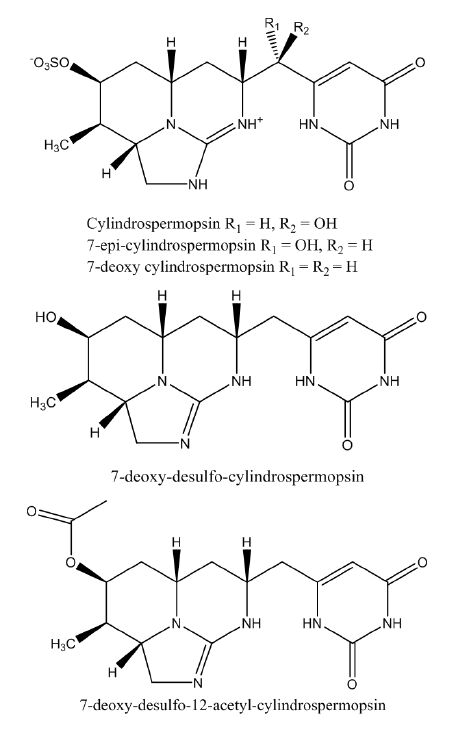
 DownLoad:
DownLoad: 